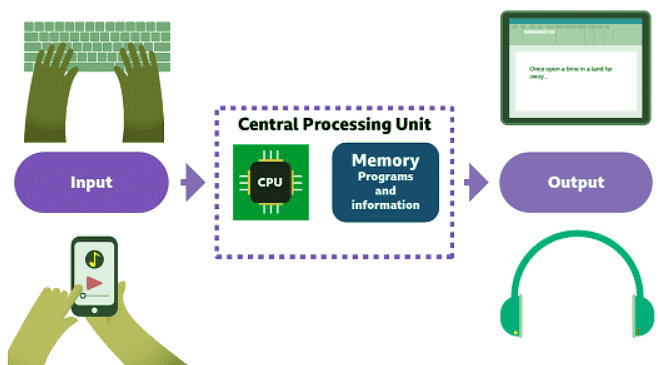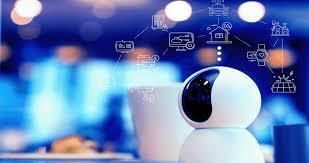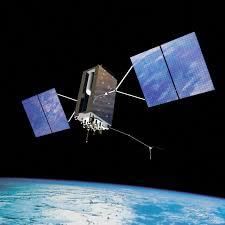Year 6 Exam > Year 6 Notes > Year 6 Computing > Inputs and outputs
Inputs and outputs | Year 6 Computing PDF Download
Computers and Information
- Computers, computing devices, and computer systems play crucial roles in various aspects of our lives. Despite their different appearances and tasks, all computers fundamentally operate in similar ways.
- They function by receiving, storing, processing, and transmitting information.
- Information that a computer receives is termed as input.
- Information that a computer sends out after processing is termed as output.
- The processing tasks are carried out by the computer processor, also known as the Central Processing Unit or CPU.
- Before and after processing, input and output information are stored in the CPU memory.

How Computers Process Information
- Program Instructions in CPU Memory: Programs consist of coded instructions stored in the CPU memory. These instructions guide the CPU on how to process input data and determine the format for output.
- Input Processing: When data is input into a computer, such as typing text on a keyboard, the program stored in memory instructs the CPU on how to process this input.
- Output Generation: For example, a keyboard inputs text which the CPU processes based on the program's instructions, resulting in text output on the screen.
- Touchscreen Interaction: Using a touchscreen to select a song in a music app is another example. The program for the music app directs the CPU on how to turn this input into sound output through headphones or speakers.

Computers and Digital Information
- Computers are designed to process digital information exclusively. All input received by a computer must be converted into a digital format for the CPU to effectively handle it.
- When information is digitized, it is transformed into a binary code, which consists of only two numbers, 0 and 1. This binary code is used to represent various letters and numbers.
- Information that has been converted into binary code is termed as digital information, while information that remains in its original form is often referred to as analog.
Question for Inputs and outputsTry yourself: What is the term used to describe information that has been converted into binary code?View Solution
Digitization of Information
- Input devices such as keyboards, touchscreens, webcams, and game controllers are created to convert received information into digital format before transmitting it to the computer's CPU for processing.
- Some output devices display processed information digitally on screens, while others convert it back to analog form, like in printouts or sound.
- Analog information is generally easier for humans to comprehend compared to digital data.
Assistive Technology
- Specialized input devices are designed to aid individuals who may have difficulty using standard input methods like keyboards or touchscreens.
- These devices may utilize sound, various movements (such as head or eye movements), or even breath as input mechanisms, enabling control over a pointer or on-screen keyboard.
- Output devices can translate text into speech for individuals with visual impairments or convert speech into text for those with hearing impairments.
- They can also provide auditory and visual alerts to warn and notify individuals of potential dangers.
- These technologies, known as assistive technologies, play a crucial role in ensuring equal access to technology for people with disabilities and unique needs.
Professor Stephen Hawking

- Professor Stephen Hawking, a renowned scientist, faced challenges due to motor neurone disease, which severely restricted his mobility and speech abilities.
- To continue his work, Professor Hawking utilized special input devices controlled by movements of his cheek. These devices enabled him to select words and communicate effectively.
- Additionally, a specialized output device transformed the selected words into electronic speech, allowing others to hear his thoughts and ideas.
New Types of Input and Output
Technology continues to evolve, offering novel ways to interact with computing devices, expanding possibilities for users.
Let's explore some examples:
- Printers: In the past, printers were limited to producing black and white text in a single font style. However, modern printers can now generate color photos with thousands of hues and even create solid 3D objects like toys and medical items such as replacement bones.

- Screens: Previously, screens were large and cumbersome, displaying small, blurry images. Today, screens offer super high-definition visuals, showcasing movies and games in stunning detail. From massive movie screens to compact watch screens, folding screens, and even screens integrated into clothing, the options are diverse.

- Shop Checkouts: In the past, shop checkouts required input from keypads, but now light beam scanners read barcodes on items, transferring information to the checkout computer for generating a printed receipt.

- Security: Previously, security relied heavily on remembering complex passwords, whereas now we can unlock digital devices using biometric data like fingerprints, eye patterns, or facial features. Some advanced security technologies analyze input biometric data to unlock devices, replacing the need for traditional passwords.

- Sensors: Sensors play a crucial role in technology by automatically collecting data from the environment and providing it as input to computing devices. Weather stations utilize sensors to gather information on temperature and wind speed, sending this data to computers for processing. The output is then displayed graphically on a screen. Special sensors in the ocean can detect movements that indicate natural disasters like earthquakes or tsunamis. These sensors send data to computers for processing and generate alerts to warn people of potential dangers.

- Satellite GPS: We receive information about our location through our mobile devices, which gather data from GPS satellites orbiting the Earth. Once the central processing unit (CPU) in the mobile device processes the location input, we see the output on our screens, displaying our location on a map. This satellite input and screen output can track our movements in real time, allowing us to monitor our position as we move around.

Question for Inputs and outputsTry yourself: Which technology allows us to unlock digital devices using biometric data like fingerprints, eye patterns, or facial features?View Solution
The document Inputs and outputs | Year 6 Computing is a part of the Year 6 Course Year 6 Computing.
All you need of Year 6 at this link: Year 6
|
19 videos|26 docs|3 tests
|
Related Searches















